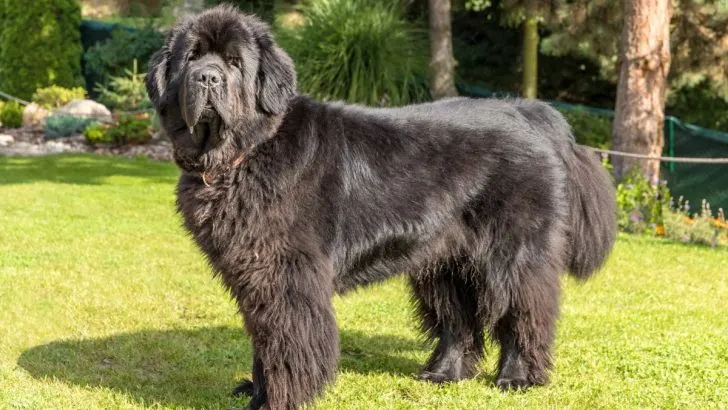Did you know that Newfoundland colors include more than just the black hues we are all used to seeing?
Well, Napoleon Bonaparte, the famous French military leader and emperor, might have just known! After all, he owed his life to a nameless Newfoundland dog.
This incredible story highlights the Newfoundland breed’s remarkable rescue abilities and loyalty.
But, what color was this dog? Was it a black dog after all? And what is it about that plush coat that makes these giant dogs so special?
Well, we are about to answer all of these questions while going through the amazing Newfoundland colors!
How Many Colors Do Newfoundlands Come In?
The Newfoundland breed of dog is known for their immense size, gentle and friendly nature, but are also admired for their stunning and varied coat colors.
Let’s explore the different Newfoundland colors and what makes each one unique.
1. Black
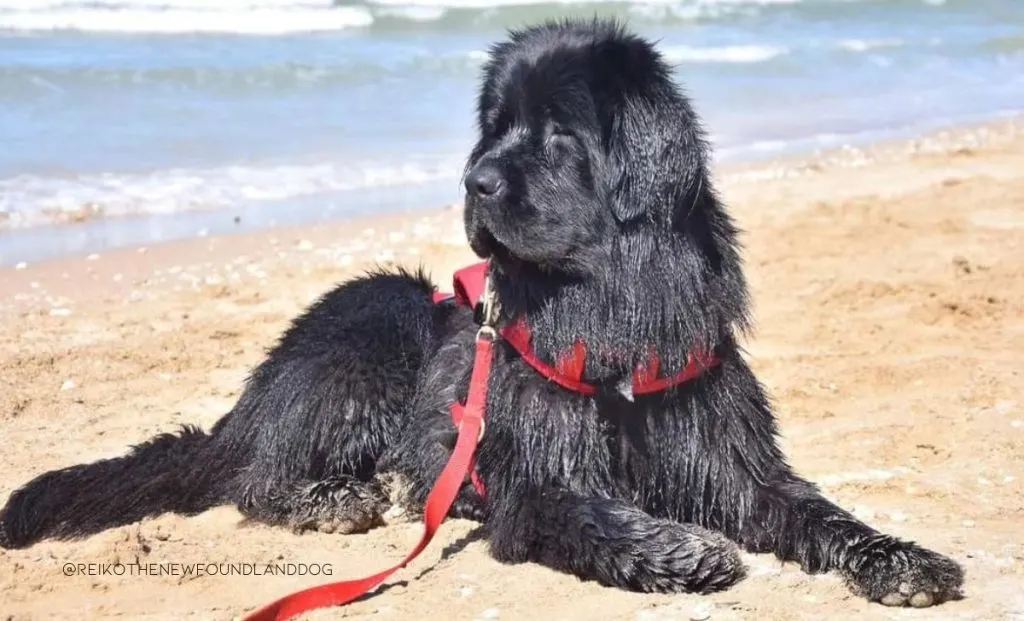
Black Newfoundlands are often the first image that comes to mind when people think of this breed, and their striking black coats make them easily recognizable.
With that said, solid black is the most common color for Newfoundland dogs. Their fur is a deep, rich black that is sleek and shiny.
This classic color gives them the appearance of big, cuddly teddy bears.
Black Newfoundlands may sometimes have a tinge of bronze or reddish in their fur.
This is often most noticeable in areas that are exposed to the sun, such as the back and shoulders.
2. Brown
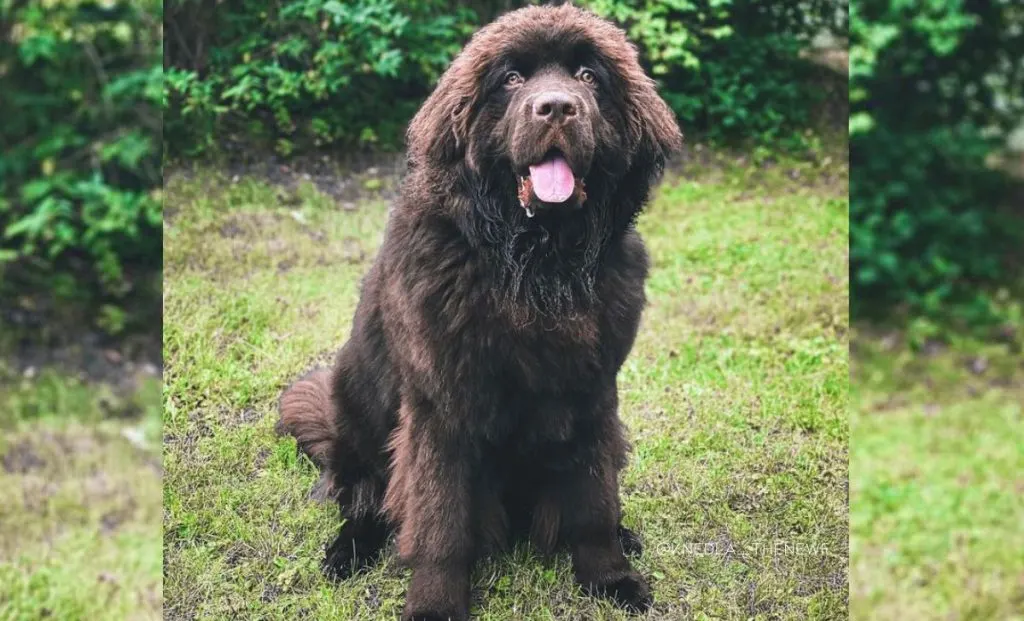
Brown Newfoundlands are just as striking as their black counterparts.
They are also known as chocolate Newfoundlands. Does it ring a bell? There is another breed of dog that is known for its chocolate color – the Labrador Retriever, of course!
Brown Newfie coat is rich, warm and can range from dark to light brown.
Their fluffy and cozy fur, alongside their large size makes them look like a soft, inviting blanket.
3. Grey
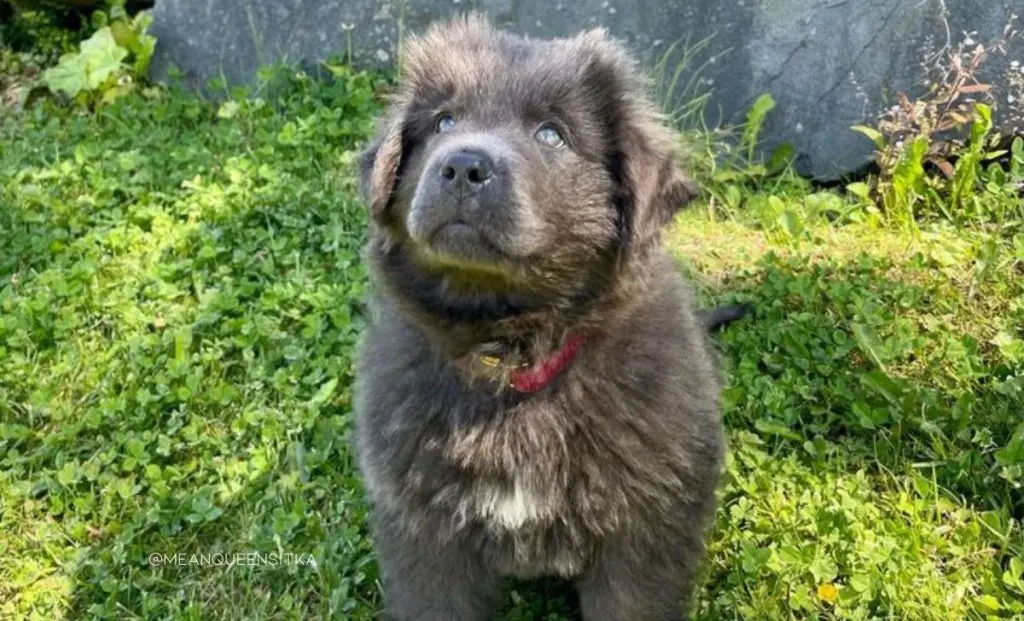
Grey is one of the rarer colors in the Newfoundland breed of dog. Newfie owners and breeders often refer to this dog as a Blue Newfoundland.
Grey Newfoundlands have a unique silver or bluish-gray fur that sets them apart from other colors. This color is less common and gives them an elegant, almost wolf-like appearance.
The gray color can vary in shade, from light silver to a darker, bluish hue.
We can see this coloration in other gentle giants such as Great Danes, Neapolitan Mastiffs, as well as some Bullmastiff mixes.
Grey Newfoundlands, just like their black counterparts, can also exhibit a tinge of bronze in their fur.
This subtle coloration can be more prominent in certain lighting conditions and might be seen on the edges of their long hair or in the undercoat.
The interplay of gray and bronze can give these dogs a unique, multi-dimensional look.
4. Landseer
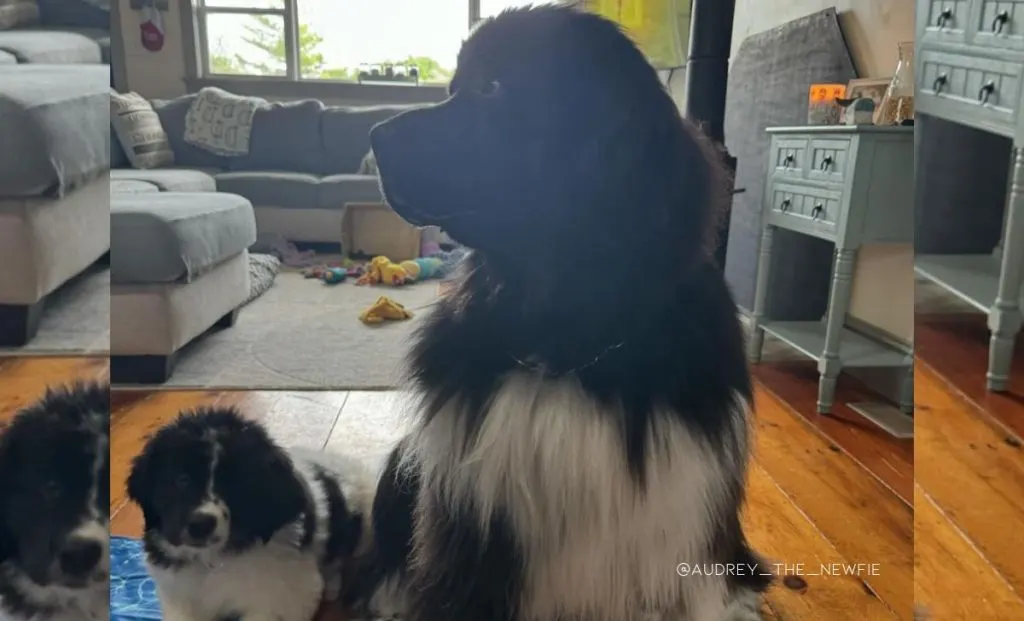
Landseer Newfies have a striking and unique pattern named after the famous 19th-century painter Sir Edwin Landseer who frequently depicted these beautiful dogs in his artwork.
The base color of these dogs is primarily white with large black markings that look like patches.
These black patches are found on various parts of the body, typically on the back, head, and sometimes on the sides. They are well-defined and contrast sharply with the white fur.
This black-and-white coat makes them stand out beautifully and gives them a unique, eye-catching appearance.
Often, the head is partially or completely black. Some Landseer Newfies have a white muzzle or a white blaze (stripe) running up the center of their black head.
Landseer Newfoundlands are often described as having a “tuxedo” look due to their contrasting colors. But, this is not the same tuxedo pattern the Boston Terrier is known for.
What Is The Rarest Newfoundland Color?
There are some rare and less common Newfoundland colors that may not be part of the standard and may occasionally appear.
1. Beige (or Cream)
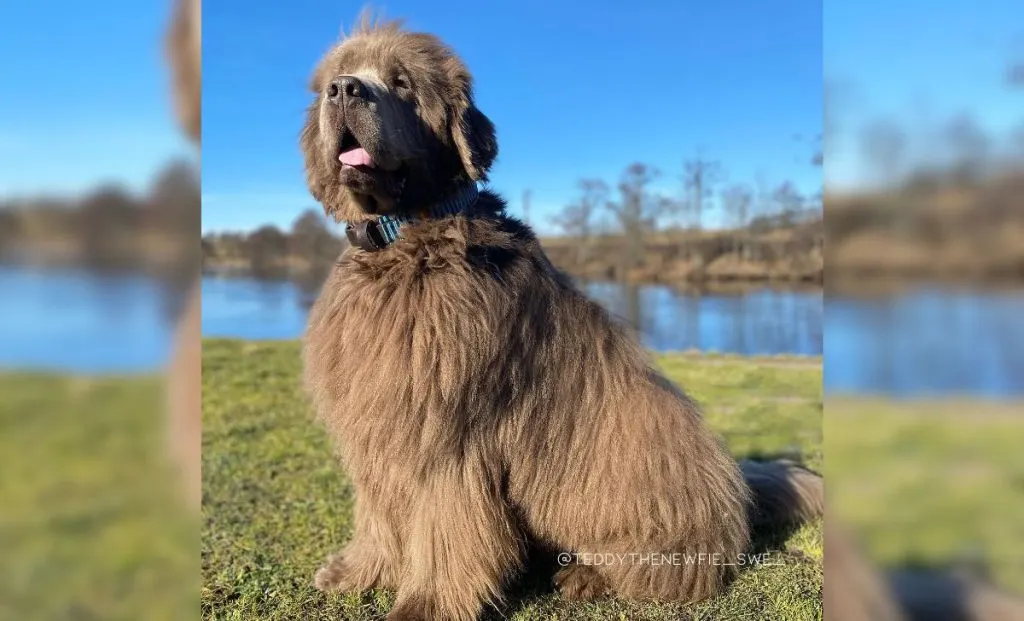
This is a very light, almost pale color that can sometimes occur in Newfoundland dogs.
Although it can be quite striking, this color is not recognized by major kennel clubs, such as the American Kennel Club (AKC), as a standard color for Newfoundlands.
The beige or cream coat lacks the pigmentation typically seen in standard colors, resulting in a much lighter and often softer appearance.
Beige Newfoundlands have a very light and diluted coat color, whereas brown Newfoundlands display a rich, warm hue.
Beige Newfoundlands may occur in litters of brown breeders who focus on maintaining the rich and consistent brown coat color. This color variation can result from dilute genes, which cause a lighter pigmentation of the coat.
2. Blue (Grey)
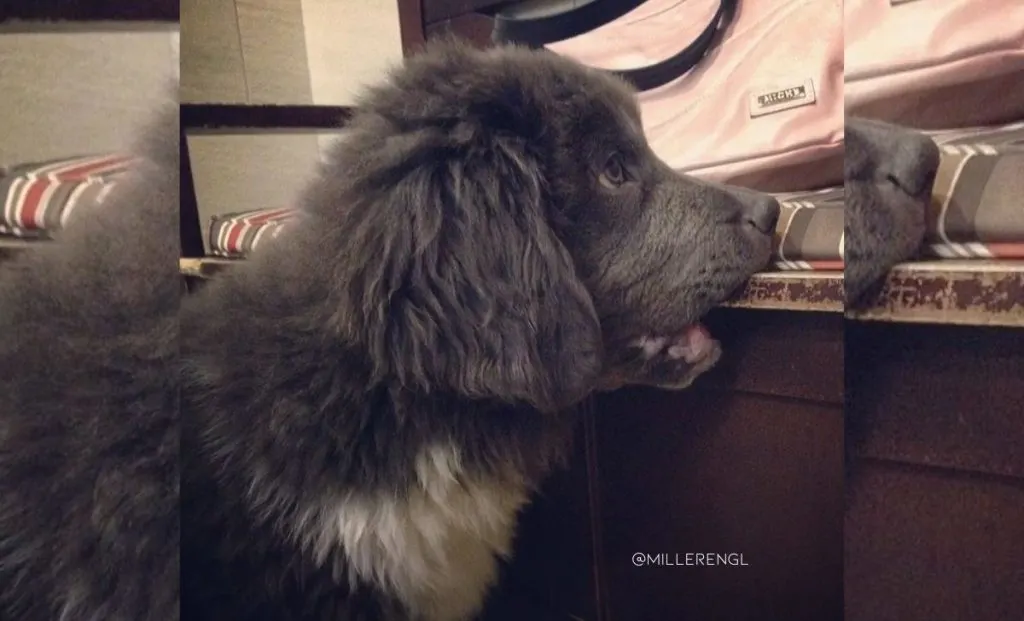
While grey Newfoundlands (often called blue) are recognized, the lighter or more diluted shades of blue can be considered rare and are not always seen in the breed.
Similar to beige, blue (or gray) Newfoundlands result from the dilution of the black coat color.
The dilute gene responsible for these variations can sometimes lead to health issues, such as Color Dilution Alopecia (CDA).
CDA is a condition that affects dogs with dilute coat colors, leading to hair loss and skin problems (1).
In any case, reputable breeders must also consider the potential health implications associated with dilute genes when breeding for specific coat colors.
3. Black And Tan
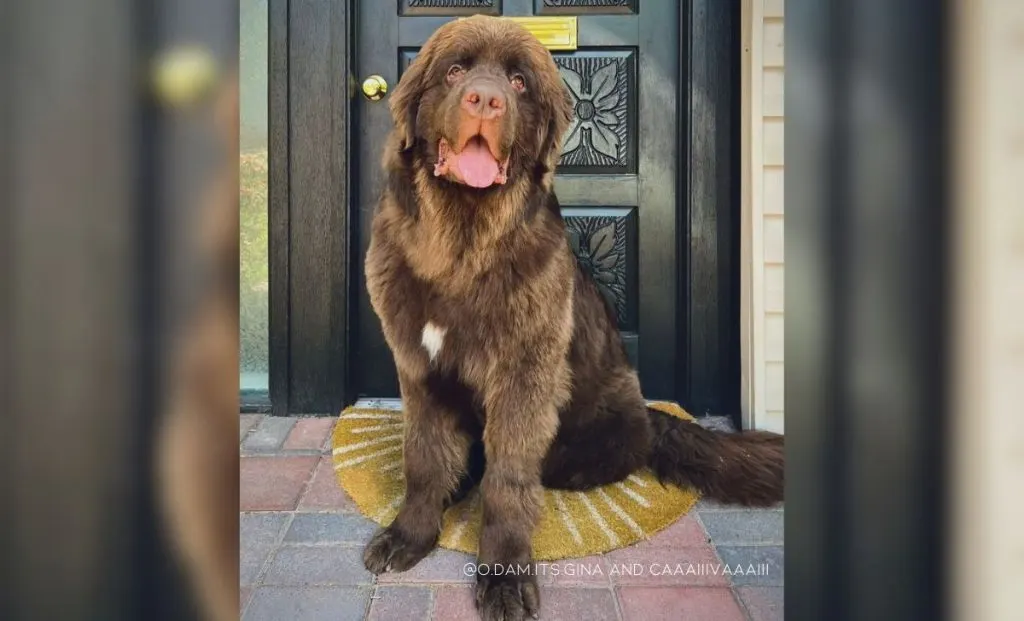
Black and tan Newfoundlands feature a primarily black coat with tan or reddish-brown markings. This pattern is similar to that seen in breeds like the Rottweiler or Doberman Pinscher.
However, this color pattern is not recognized by major kennel clubs like the AKC, as it falls outside the breed standard for Newfoundlands.
4. Brown And White
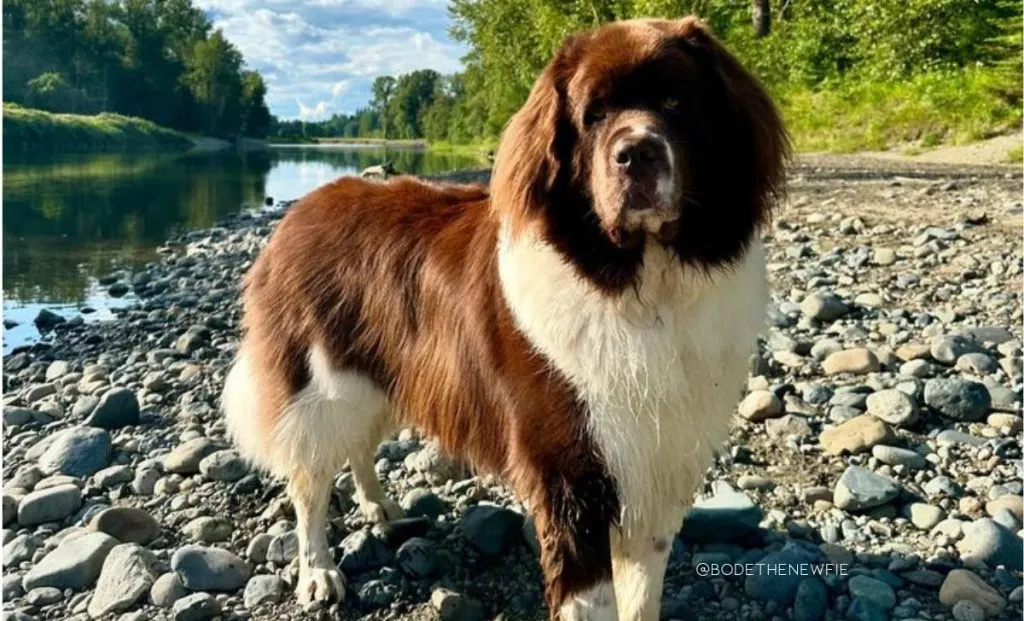
Brown and white Newfoundlands have a combination of brown and white patches, similar to the Landseer pattern but with brown instead of black.
This is another Newfoundland color that is considered rare but also not recognized by the AKC.
Let’s explain these markings and patterns a bit!
Newfoundland Markings And Patterns
Markings and patterns in the Newfoundland breed of dog not only enhance their visual appeal but also play a role in breed identification and adherence to breed standards.
1. Irish Spotted
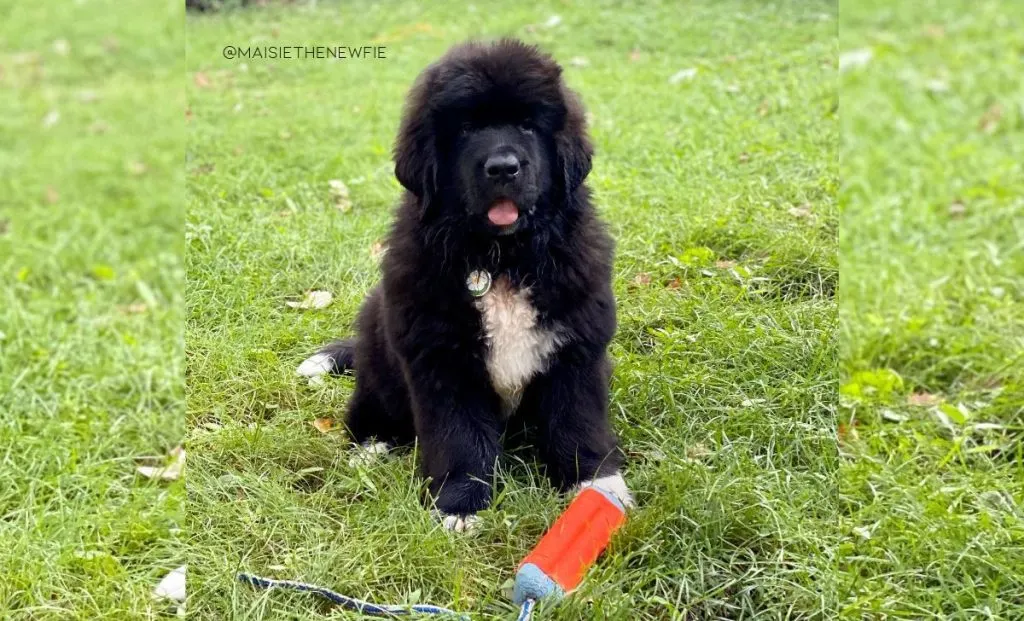
Irish Spotted Newfoundlands are predominantly black (or another solid color) with specific white markings.
White markings typically appear on the chest, toes, and tip of the tail.
It looks like the dog dipped its paws and tail in white paint!
2. Black With Tan Points
This pattern features a primarily black coat with tan or reddish-brown markings. It gives the appearance of the dog wearing little tan socks and gloves.
The tan points are usually found above the eyes (eyebrows), on the muzzle, chest, legs, and under the tail.
3. White Blaze
A white blaze is a narrow strip of white fur running down the center of the face.
This marking starts from the forehead and extends down the nose, giving the dog a distinctive and eye-catching feature.
It is often seen in Landseer Newfoundlands but can also appear in other color variations.
We can also see this marking in other breeds like the Australian Shepherd, Border Collies, and Greater Swiss Mountain Dogs.
What Colors Are Accepted For Newfoundland?
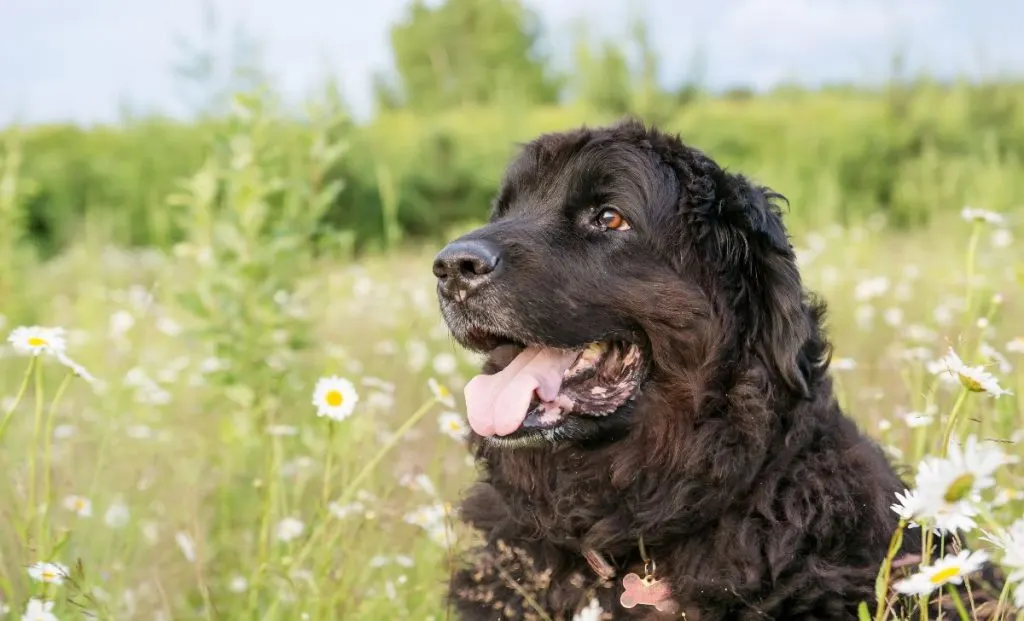
While most Newfoundland colors are recognized by major kennel clubs, there are some that don’t make it to the official breed standard. What I mean by acceptable Newfoundland dog colors is that these are recognized by The Newfoundland Club of America and The American Kennel Club (AKC).
You see, Newfoundland colors are more than just an aesthetic attribute. They play a role in breed identification and adherence to breed standards.
Recognized colors help maintain the integrity of the breed and ensure that each dog meets the historical and functional characteristics that define Newfoundlands.
The American Kennel Club (AKC) has specific breed standards for Newfoundland dogs to ensure they maintain their distinctive characteristics.
That said, The American Kennel Club recognizes Newfoundland dogs in four primary colors:
- Black
- Brown
- Gray
- Landseer
As you can see, the major kennel club in the United States considers Landseer as a color variety of the Newfoundland breed of dog. However, there is a catch with the Landseer ECT (European Continental Type) Newfie.
In contrast to the AKC, the International Federation of Kennel Clubs – Fédération Cynologique Internationale (FCI) recognizes the Landseer (European Continental Type) as a separate breed from the Newfoundland.
So, when it comes to Newfoundland colors, according to the FCI, the Landseer ECT is a separate breed that has a distinct black-and-white coat, characterized by large, well-defined black patches on a white base color.
On the other hand Newfoundlands recognized by the AKC can be black, brown, gray, or Landseer (black-and-white).
What Color Are Newfoundland Eyes?
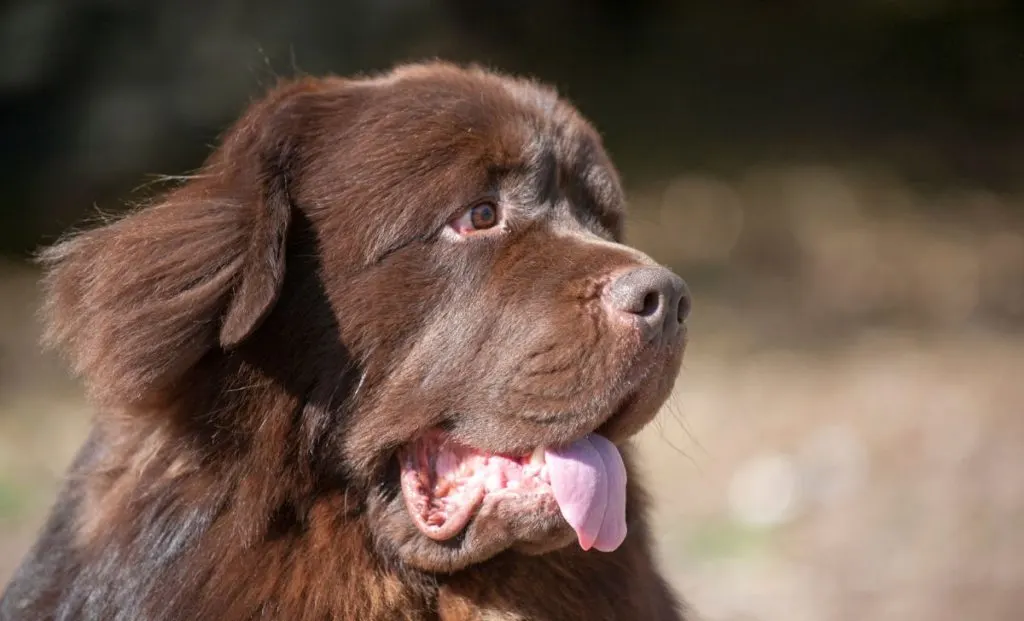
The eye color of Newfoundland dogs is typically influenced by their coat color due to shared genetic pathways that control melanin production.
Historical analysis shows that the introduction of certain coat color genes, such as the ‘Solid’ gene, also brought changes in eye color among Newfoundland dogs.
This gene was introduced into the population in the 1840s, leading to changes in both coat and eye pigmentation patterns over time (2).
Eye color is an important aspect of the overall appearance of Newfoundland dogs and is considered in breed standards set by kennel clubs.
Darker eyes are generally preferred, as they contribute to the breed’s gentle and expressive facial expression.
Black Newfoundlands generally have dark brown eyes that complement their deep, rich coat color, giving them a soulful and expressive look.
Similarly, brown Newfoundlands also feature brown eyes, which can range from medium to dark brown.
Gray, or blue, Newfoundlands often have lighter brown or amber eyes.
Landseer Newfoundlands typically have dark to medium brown eyes. The eye color contrasts nicely with their coat pattern, doesn’t it?
No matter their eye color, Newfoundland dogs have the most adorable puppy eyes that melt hearts and make them irresistibly charming!
Newfoundland Coat Type
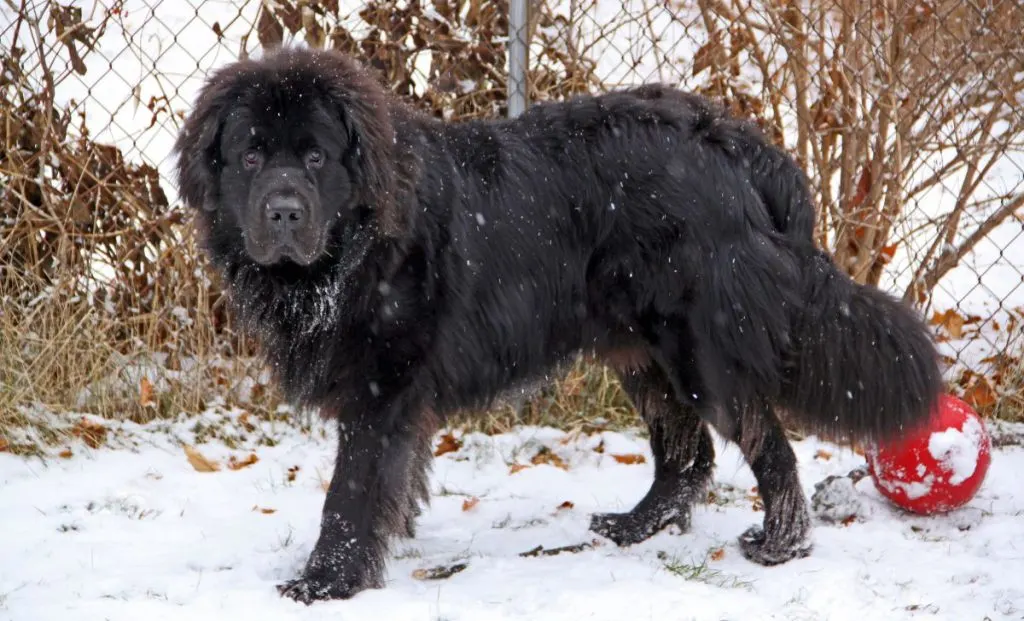
The coat of a Newfoundland is a key feature that not only enhances their appearance but also serves functional purposes, especially given their history as working dogs in harsh climates.
Double Coat
Purebred Newfoundlands have a dense, double coat that is designed to protect them from cold and wet conditions.
The undercoat is soft, thick, and insulating, providing warmth and protection against cold weather.
This layer helps to regulate the dog’s body temperature, making them well-suited for swimming in cold waters.
The outer coat is longer, coarse, and water-resistant. This outer layer can vary in length but generally remains straight or slightly wavy.
It serves to repel water and dirt, keeping the dog dry and clean.
Shedding
Newfoundlands are known to shed, especially during seasonal changes in spring and fall.
During these times, they blow their undercoat, just like Siberian Huskies.
This means they shed the thick undercoat to adapt to the changing temperatures.
Regular grooming is more than important during these periods to manage shedding and maintain a healthy coat.
Easy Grooming Tips For Newfoundland Dogs
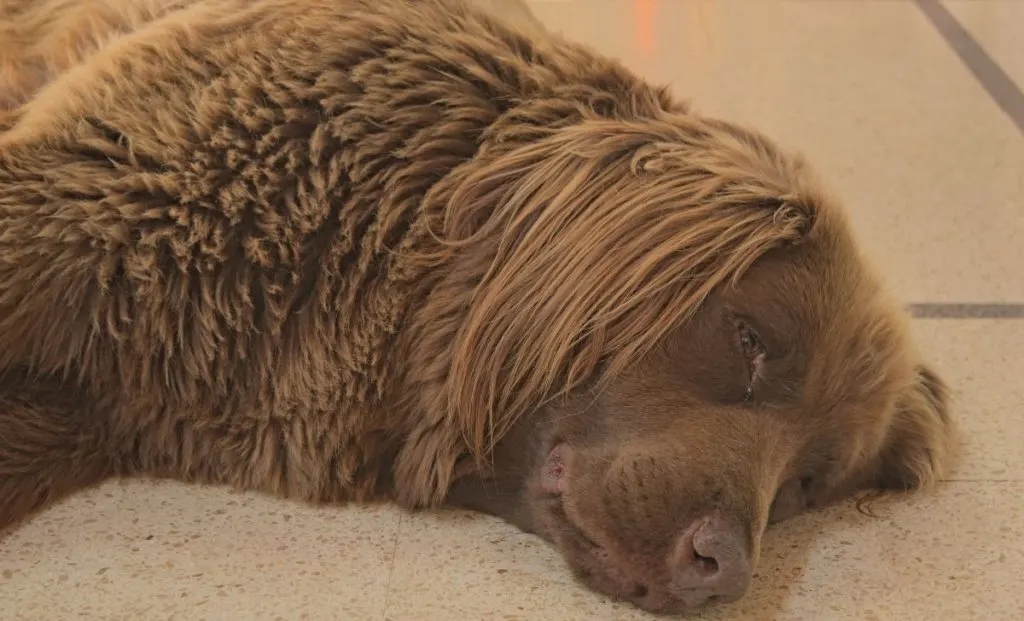
Newfoundland dogs are big, friendly, and have beautiful, thick coats that need regular care to keep them looking their best.
Well, their double coats along with intense shedding are a solid reason to give you some grooming tips!
Daily Brushing
Newfoundland dogs have lots of fur, so brushing them every day helps keep their coat nice and smooth. This daily routine prevents tangles and mats from forming in their dense fur.
Use a slicker brush to get rid of Newfie’s loose hair in the outer coat. Also consider using an undercoat rake to reach the thick fur underneath.
Make sure to brush in the direction the fur grows to keep it neat and comfortable for your dog.
Also, regularly brush them, as this will help spread natural oils across their coat, keeping it shiny and healthy.
And you know what that means? Those magnificent Newfoundland colors will come to light!
Bath Time
Your Newfoundland should get a bath every couple of months or whenever they get really dirty from playing outside.
Make sure to use special dog shampoo and conditioner to keep their fur soft and smelling fresh.
After the bath, dry them well with towels and a pet dryer, paying extra attention to the thick fur underneath to make sure it’s completely dry.
This prevents skin problems and keeps them comfortable.
A clean, dry coat also helps protect your dog from cold weather and keeps them feeling cozy.
Trimming Fur
To keep your Newfoundland looking tidy, trim the fur around their paws, ears, and bottom every few weeks. This is very important because it will help you notice dirt and also prevent it from getting stuck in their fur.
Make sure to use grooming scissors or clippers to carefully trim these areas.
Remember to do it gently and do not cut too close to the dog’s skin.
You should never shave your Newfoundland!
Their double coat is essential for protecting them from both heat and cold, and shaving can disrupt their natural temperature regulation and skin protection!
Nail Care
Keeping your Newfie’s nails trimmed is important for their comfort and health.
Trim their nails every three to four weeks to keep them from getting too long and causing discomfort when they walk.
Use a sturdy nail clipper made for big dogs and be careful not to cut too far, which can hurt your dog.
If you’re not sure how to trim their nails, ask your vet or a professional groomer to show you the best way to do it.
Cleaning Ears
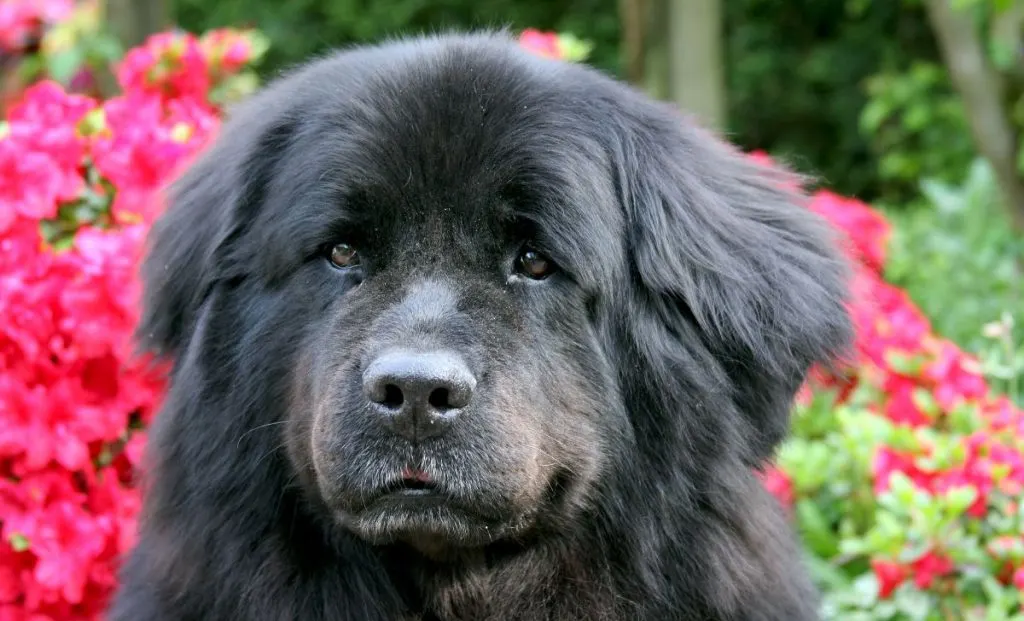
Check and clean your dog’s ears (almost) every week to prevent ear infections.
Newfoundlands have floppy ears that can trap moisture and dirt, so it’s important to keep them clean.
Yeah, they are not as floppy as those in the Basset Hound, but that doesn’t mean that they do not require regular cleaning.
Use a gentle ear cleaning solution and cotton balls to wipe the visible parts of the ears. Avoid sticking anything (Q-tips, gauze, cotton wool) deep into their ears, as this can cause damage.
Brushing Teeth
Just like people, Newfoundland dogs need their teeth brushed to stay healthy.
Brush their teeth a few times a week to keep their mouth clean and prevent tartar buildup.
You can use a toothbrush and toothpaste made for big dogs and gently brush in circles.
This will help prevent bad breath and keep their gums healthy.
Not only that, but regular dental care can also help prevent more serious health problems later on (3).
Professional Grooming
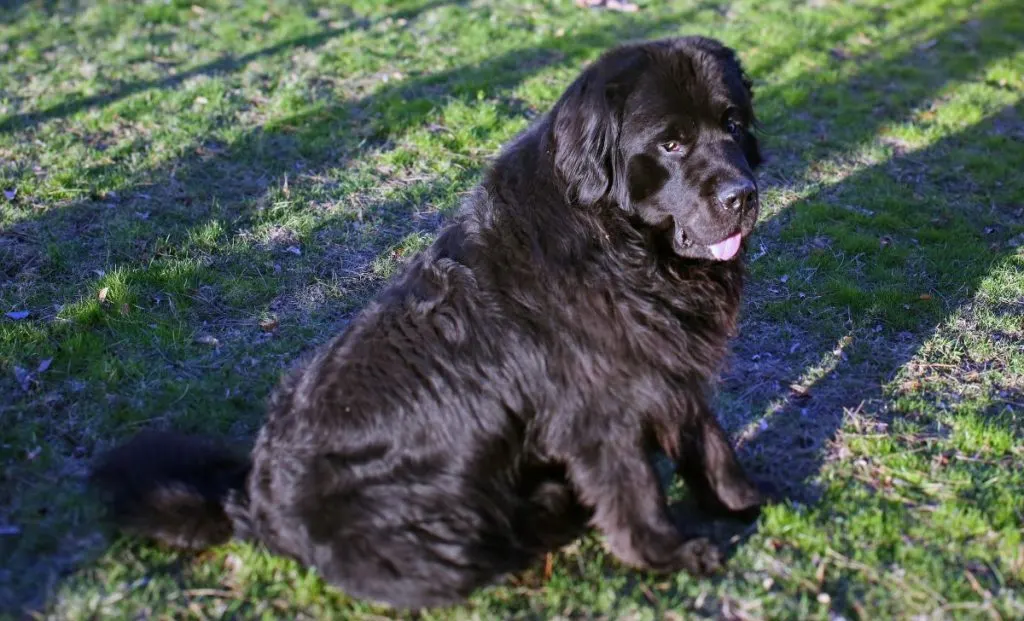
Sometimes, it’s a good idea to take your Newfoundland to a professional groomer every few months.
Professional groomers have the tools and experience to give your dog a thorough cleaning and trim, keeping their coat in great shape.
They can also help with things like nail trimming, ear cleaning, and checking for skin problems.
Regular professional grooming can make a big difference in keeping your Newfoundland looking and feeling their best.
Grooming your Newfoundland dog is important to keep their coat healthy and beautiful, no matter their coat color!
Plus, spending time grooming your dog is a wonderful way to bond with them and show them how much you care.
So, to keep those Newfoundland colors as bright and shiny as possible, make sure to take good care of these adorable gentle giants!
References
1. Kim, J., Kang, K., Sohn, H., Woo, G., Jean, Y., & Hwang, E. (2005). Color-dilution alopecia in dogs.. Journal of veterinary science, 6 3, 259-61 . https://doi.org/10.4142/JVS.2005.6.3.259.
2. Bondeson, J. (2015). Historical analysis of Newfoundland dog fur colour genetics. Open Veterinary Journal, 5, 85 – 89. https://doi.org/10.5455/ovj.2015.v5.i1.p85.
3. Enlund, K., Pettersson, A., & Eldh, A. (2022). Dog Owners’ Ideas and Strategies Regarding Dental Health in Their Dogs-Thematic Analysis of Free Text Survey Responses. Frontiers in Veterinary Science, 9. https://doi.org/10.3389/fvets.2022.878162.

Meet Iram, a devoted veterinarian, passionate dog lover, and current Ph.D. candidate at Utrecht University in the Netherlands. Seamlessly blending her roles as a vet and content writer, Iram channels her love for dogs into heartfelt narratives.
Since childhood, Iram nurtured a dream of becoming a vet, a passion that runs deep in her family. Having now fulfilled that dream, she’s eager to share her acquired knowledge. In her writing, Iram not only explores the emotional bond between humans and their canine friends but also integrates her veterinary expertise, offering readers a holistic understanding of their beloved pets.
